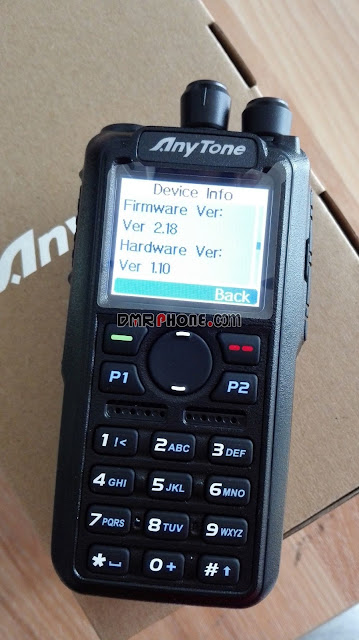The
Anytone AT-D868-UV is a VHF and UHF hand held radio with both Digital
DMR Tier I and Tier II and Analog capabilities. It offers a total of
4,000 channels (Analog and Digital), 10,000 Digital Talk Groups and up
to 150,000 contacts, as well as multiple DMR ID numbers for a single
radio. Retailing at £139.95 from Martin Lynch, the AT-D868-UV is
extremely good value for money.
The radio comes with a short stubby dual band antenna and a charging cradle. The short antenna is adequate for normal use but the use of a longer 40cm Diamond SRH-771VHF/UHF Handheld Antenna is much more practical.
The
AT-D868-UV is easy to program and a Word document is available on-line
which is easy to follow. The Anytone codeplug is slightly different to other units
to program but it does not take long to get used to it. The code plug
program is easy enough to use but it does differ from the Tytera and
Motorola approach. The first few entries did take time as the program
was a little unfamiliar but, after the first ten had been programed it
was easy to get into the order and rhythm of the program.
Starting from scratch, the Talk Groups are programmed in first.
It
is necessary to type in the number of the TalkGroup, Give it a name and
also define the type of call which in most cases will be a Group Call.
Setting up the Channels and defining mode and frequency is the next task using the screen below:
As
with most CPS programming the Channel Name, the Channel Mode and the
frequency is required. If Analog modes are used it is possible to define
the squelch type and tones required.
With
DMR channels it is necessary match the channel name with the Digital
contact or TalkGroup, set the colour code and TX permit. This rig also
requires the Radio ID to be defined for each contact. It does default to
the first on the list so it is not a problem. It is however possible to
define the ID of the radio for specific channels. If you are on holiday
this may be a useful facility.
Lastly the zone has to be defined and appropriate channels assigned to it.
The creation of a Zone and the addition of channels is a simple task and much like any other radio.
Whilst
not really required, a Scan List and/or a Receive Group List may be
created if the listening to or monitoring of multiple channels is
required.
The
radio has been put through it paces and the first thing to note is the
good quality of audio from it. Secondly, the receive side is sensitive on
both DMR an Analog Channels. The first test was with the 70 cm GB7NS Repeater located in Caterham and some 8 miles from the G4GFC QTH. The path was not line of sight and there were many obstructions in the path as the G4GFC QTH is surrounded by woodland. It was possible to access the Repeater using low power and a good report was received. Using the Diamond SRH-771 antenna resulted in an increase in received signal. GB7EP and GB7AK located at Epsom and Barking, north London were not workable, however, walking to a higher location would have made this possible. The G4GFC QTH is located behind hills in the direction of GB7EP and GB7AK. GB7AK would undoubtedly be the repeater of choice whilst pedestrian mobile in London by virtue of its location.
The stubby antenna does not really do the
radio any favours, but, the addition of a longer antenna such as the
Diamond SRH-771VHF/UHF Handheld Antenna is a vast improvement. This a matter of taste really
as the longer antenna gets in the way but it is far more efficient. It
is really down to the type of work you wish to use the radio for at the
end of the day. There is no doubt that the existing antenna will work
from point to point over a clear path and from high ground the longer
antenna will undoubtedly prove its worth.
The radio has a high quality plastic case and it does not feel as though it will fall apart if accidentally dropped.
The
battery capacity is excellent at 3100 mAH for normal use. Obviously
constant use at 5 - 7 Watts will reduce the battery life before needing a
charge.
As
a dual bander, this radio would definitely be my first choice as it
ticks more than most of the boxes and well worth the money. The code
plug software is easy enough to use although it is slightly different to
its competitors
A Code plug for this radio can be found on the Galway VHF Group Facebook Page.














